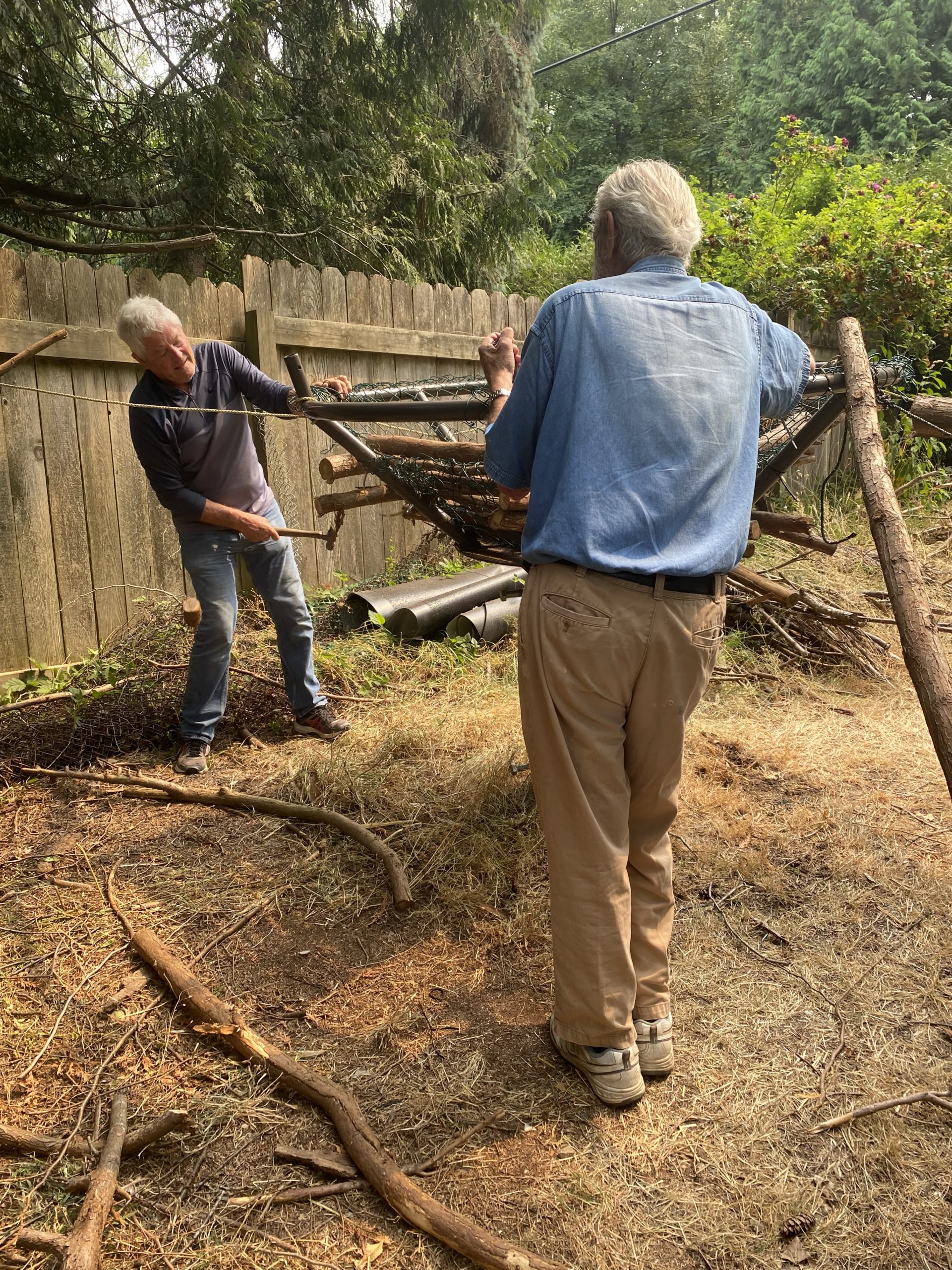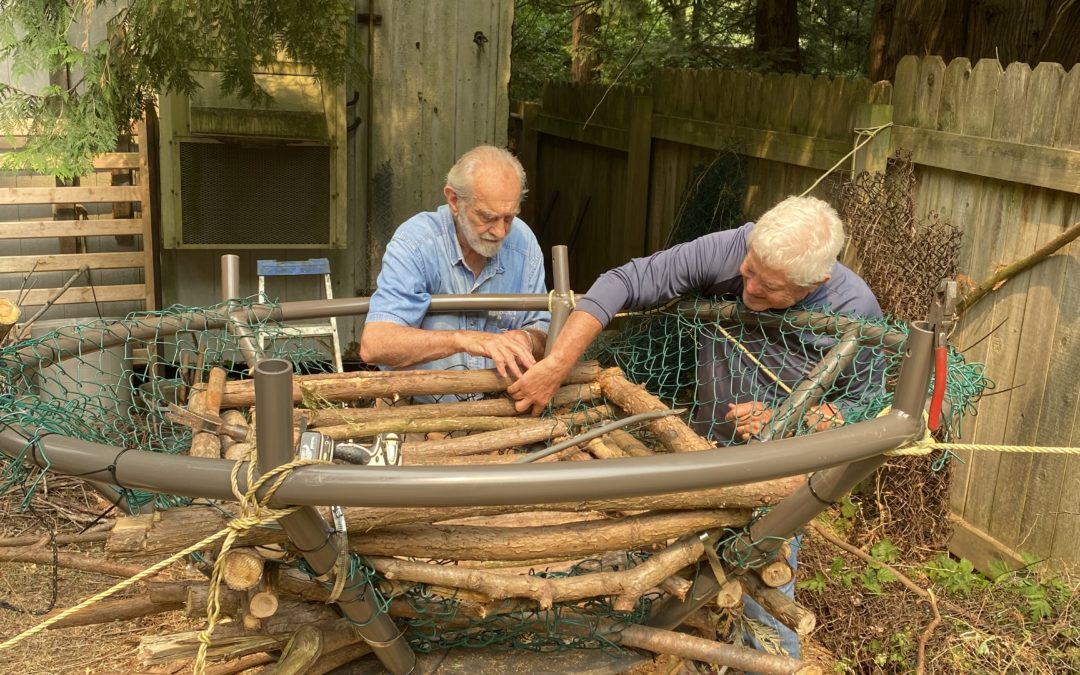Hancock Here:
Why do eagles need help with building or rebuilding their nests? Can’t they build their own nests? Hundreds do this all the time! Most certainly they can build beautiful and functional nests — they have been doing this for a million years.
So why do we now need to intervene? Well, the answer is straight forward. For an eagle to build a five-to-eight foot-across nest, one hundred feet up in a big tree, several key ingredients are required. Guess what? We humans are responsible for eliminating most satisfactory trees. Sure, you see many trees – certainly we are slowly growing 100 foot or 30-meter-high trees! But for an eagle, capable of carrying a maximum of about three pounds, or two kilos, some very specific conditions must be present.
First, the eagles need a nest above the roar and thunder of the baby carriages, runners, barking dogs, swerving bikes, killer cars, and screaming kids kicking footballs. Second, the tree branches need to be big enough to hold a 200 to 300 kilo nest. These branches need to be 10 to 20 cm minimum in diameter — and be alive and viable – for years to come. Then, most key of all, the placement of these key support branches must be arranged around the trunk at a similar height to support the initiation of the first few foundational branches.

Is there space for the eagle to fly in and place these first branches? Will they stay in place across a minimum of two supportive branches? Is the height, and the structure conducive to place more sticks? Can they fly in and out without damaging their wings?
Will the eagles have room to stand and fly away? Or more importantly, can the eagle stand on the growing nest without bumping into branches above that nest? Is there room for the growing nest to increase in height to 30 to 100cm – one meter in height. The eagles need height to move about the nest, and rear two or three rambunctious young!
They know they would like shade-creating branches above, but this option may be sacrificed. Let’s hope their new nest has a sea-breeze or there will be hundreds more eaglets jumping off the nest to enjoy a few seconds of cool air between their hot blood-filled feathers – before they splat on the ground! That was an unusual story repeatedly acted out during this season’s hot spell.
An old 300-to-500-year-old fir or cedar may well have 15 cm+ diameter branches 25 or more meters up from the ground. If that first 400-year-old tree does not have the right supportive structure, then perhaps the next will – or the next after that! Yep – if the first tree in the desired territory with the perfect seashore oversight is not satisfactory then the next tree will be!
So, how many of you know an area with a row of 300-to-500-year-old trees from which to choose a strong suitable branch structure with the correct spacing – below and above? Please, please tell me – I know of 300 pairs of eagles in the valley wanting more adequate trees in which to build a nest! What we humans have left behind after we have cleared the area for homes, views, industry, profit, and roads is scrub-brush.
After removing most of our coastal forests, we are just starting to grow a few fast-growing cottonwoods, or a few left-over conifers that might just reach 35 meters but rarely support a huge eagle nest for very long. Well, I am speaking pessimistically as our eagles have been so accommodating that they have built nests in so many structures that two hundred years ago no self-respecting eagle would have given a second look. Today, a major statement the eagles make to say they do not have enough trees is that I have eleven nests in the Vancouver area constructed on the top of Hydro and Cell towers. Thank goodness they are adaptable. Many hundreds of other nests sit precariously on thin branches waiting to fall.
But that adaptability has limits. My role has been to try and extend their inventiveness to new heights – well, perhaps lower heights and smaller branches that we have given supplemental support to making them look bigger and stronger. And I have to say we have now honed our nest building skills so that every one of the last many nests we have built have been 100 % occupied by eagles. They like how we improve an unacceptable tree branch structure into an acceptable nest. It is quite satisfyingly marvellous as each new nest is occupied by a pair of eagles returning from migration.

When we received the first invitations by government biologists, who had seen our early successfully occupied artificial nests, they wanted these skills employed when industry or developers were removing or destroying established eagle nests. It was an invitation I had long worked toward. However, many big challenges were still before us.
For example, one of the first nests we replaced was on the Esplanade just west of St. Andrews Avenue in North Vancouver. The Harbour Board wanted to expand the parking lot for coal train tracks below the Esplanade. The steep bank, with its productive and occupied bald eagle nest, was going to fall, as the cliff was carved away for vehicles and trains. The public was outraged. Even the press thought this was too much even for our all-important coal shipments to China.
The media pitch came on strong. Finally, the day the felling crew arrived at the tree, some screaming public shouted from the sidewalk directly below the nest, the Wildlife Branch called me to come and offer a solution. Could some intervention save the eagles and them from another bad day of publicity? Well, I was between a rock and a hard place! It was January and the eagles had been building their nest every day. They flew overhead screaming, as they were preparing to lay their eggs in late February or early March. I know we would not climb a nest when the eagles were present, but I had not spoken forcefully about this opinion.
As the feller approached the tree, the public screamed louder. It was dramatic. What might save the eagles was on my mind. What would reduce the public’s outrage would make the wildlife officials happy. What would quickly get the public outrage and the eagles nest gone was on the Harbour Board mind – all they wanted was a parking lot for coal trains. I knew the Harbour Board had already received the Removal Permit. So, how could we finesse the day to the eagles’ favor? I decided it was now or never.
Now, I need to digress a bit. At this point in time, I had built a few successful nests in trees. Earlier, I had a request to build a nest on a pole to replace many trees in a huge gravel operation at Sechelt. However, while I produced an aluminum nest to go onto a pole, I was not shown or allowed to see where this nest was going to be placed until I delivered it to the site. What a moment of disappointment – and disillusionment. I had viewed on maps the gravel operation, from the cleared mountain side to where the huge conveyor belt delivered the gravel to the waiting barges on the shoreline. I could see on my maps all sorts of shoreline where eagles would love to nest. Of course, I could only assume their nests were gone because the area had lost all its big trees.
Indeed, the assumption made an ass of me. They wanted to place my nest over a mile inland where they had scoured the dry hillside of trees and wanted to bring eagles into this barren gravel pit area. What a wonderful objective that was totally unrealistic. Getting eagles to carry dinner a mile inland from their food supply on the coast was not in any eagle’s bag of resources. This pole nest, however, was immediately adopted by a pair of ravens so I can now add ‘raven nest builder’ to my resume. Do you know anybody wanting a raven’s nest built for them – the Foundation’s consulting fees are very reasonable! This project did not lend any credence to my eagle nest building reputation or my confidence that others should be selecting the time and place of installing replacement nests.
So, back to the Esplanade. It was January 22nd and I offered to build a nest at the waters’ edge below this Esplanade nest site. While I was down evaluating this shore-side site with two of the Wildlife and Harbour Board officials, we collectively settled on a deal that hopefully would bring peace to the warring parties. It was resolved that for the removal of this Esplanade nest the Harbour Board would build three replacement nests. Wow! It was accepted. The Wildlife officials and I had discussed this option some time earlier and now, apparently, it was going to be a reality. Minutes later, I learned the Harbour negotiator had phoned his crew about this deal and within seconds the nest was down — amid screaming eagles and irritated people.
There was no acknowledgement of any waiting for the nesting season to end – the nest was already gone. But, and in the end, this has become a huge win for conservation. That decision to replace each removed nest by three nests has become the principle for not just mitigating a lost nest but rebuilding nests throughout the province. This policy now needs a bit of massaging. As we get more control over wasteful destructive developments, we need these mitigation efforts to move into funding and improving many degraded habitats. A wonderful mitigation philosophy was born to help rebuild habitat lost over years of neglect.

In the next week we designed this Esplanade Nest and had it constructed. We erected our nest on an 80-foot pole at the waters’ edge. While we were erecting the pole, a lady came up to us and pointed up to the shoreline to Alder Street where she lived. She said a pair of eagles had spent the week building a new nest in her back yard. That pair of eagles, the previous Esplanade nest-owners, was establishing a new nest. Our nest pole just below them, which they obviously watched us erect, was neglected.
This waterfront nest in all its glory has sat unused for over ten disappointing years. Now I have modified many more trees and erected more pole nests. Today, we would never remove an active nest and install the proposed new alternative nest if the adult eagles were around watching. The adults need to be away on migration: otherwise, they see how the new site can be violated by humans. The Esplanade and Sechelt experiences were important lessons that led to many wonderfully productive nests – all erected while the parents were off on migration.
Currently, we want to refurbish the lining of this Esplanade nest with new cedars and an inner lining of nice decomposable cottonwoods to make the inside damp to keep eggs moist and soft to protect their bare skin brood-patch. The Hancock Wildlife Foundation will collect all the bundles of wood, about 150 kilos, purchase the 100 stainless steel strappings and rent the 45m lift. But this all costs about $3,500 to $4,000. Our team of volunteers will of course build the nest.We have just launched a drive to raise these funds. If we get more funds than needed for this nest, we will apply these funds to the next nest that needs refurbishing – and there are many in the lower mainland. Please help us re-build eagle nests in places the eagles can’t.
For some images of a fine successful pole nest see the Nelson Road nest in Richmond. This nest produces two young almost every year. Our Delta2, White Rock and Surrey Reserve CAM nests are all artificially constructed nests we built.
By the way, the Vancouver Park Board last year funded rebuilding a perennially failing nest in Hastings Park. This year it produced three chicks. One was caught on the ground, spent a week at OWL, our incredibly successful rehabilitation center for raptors, and it was fitted with a tracker. Yesterday it joined the eaglet from Vanier Park nest —- on the Kitimat River feasting on spawned-out salmon.
You can follow our tracked eagles and watch our nest CAMS at www.hancockwildlife.org. At this site you can also donate to the not-for-profit Hancock Wildlife Foundation and get a tax receipt. This will help us build more nests or learn where our wintering eagles and/or our breeding eagles are coming from or going to! Maybe your company would like to sponsor a nest? Or a migrating eagle as it travels? Help keep Super Natural British Columbia super and natural.
Keep safe,
David Hancock

